Geology and Natural Heritage of the Long Valley Caldera
The Bishop Tuff : An Overview of the World’s Roughest and Toughest Volcanic Landform
Charity J. Southworth
Abstract
The Bishop Tuff is a welded tuff that was created 760,000 years ago during one of the largest volcanic eruptions on Earth. This paper will discuss the size of the Bishop tuff and the single magma chamber that caused the eruption and its suggested physical properties. The geography of the Bishop ash fall stretches across the western United States, while the Bishop Tuff extends across the Long Valley and Mono Basin regions. Stratigraphy of the tuff suggests a timeline for the 6-day eruption resulting in the Bishop tuff. Cooling processes and formations are visible within the tuff at the Owens River Gorge. The concluding volume of the Bishop tuff is thought to be 600 km3, with a maximum thickness of 1,500 m.
Introduction
The Bishop tuff is a welded tuff that was created during the volcanic eruption that formed the Long Valley Caldera in eastern California. A welded tuff is made up of pyroclastic flow material, as well as ash fall, that had enough heat to weld together when it was deposited. The strength of the welding can decrease when further from the source, in the upper part of a deposit, or on thinner deposits because there is less material, and therefore less of a compacting force to help weld the tuff. The largest exposure of the Bishop tuff is located on the Volcanic Tableland that is southeast of the caldera (Bailey, 1976). Other exposures are found in parts of the Adobe Valley and in the southern part of the Mono basin (Bailey, 1976). In total, the Bishop tuff is about 200 km3 in volume outside of the Long Valley Caldera, and about 345 km3 inside the caldera (Fig. 2). The Bishop tuff within the caldera is probably 1000 m thick. Studies of the caldera suggest a thickness of 1000–1500 m (Hildreth, 2007). A layer of the Bishop Tuff was encountered in a well drilled on Paoha Island, Mono Lake, at a depth of 430 m (Hill, 2006). Fallout from the eruption measures >2,5 x 10 km2 in area, from the Pacific ocean to Nebraska (Fig. 1) (Hildreth, 2007). The material that created the Bishop tuff was released during a 6 day long eruption from the Long Valley magma chamber ˜760,000 years ago (Hildreth, 2007).
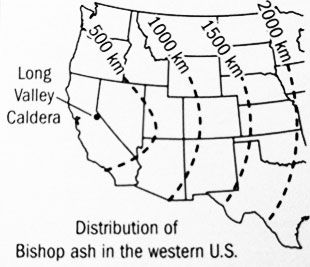
Fig. 1 Distribution of Bishop ash in the western U.S. (Hill, 2006)
The Bishop tuff is a rhyolite tuff that is crystal rich; it contains up to 30% phenocrysts, some of which are quartz (Bailey, 1976). Rhyolite is a type of rock with felsic composition that is an igneous rock. Rhyolite tuffs tend to be made of pumiceous and glassy fragments. The Bishop tuff does not differ dramatically from top to bottom in composition and is not strongly differentiated. The tuff consists of volcanic ash, and pumice lapilli (Bailey, 1976).
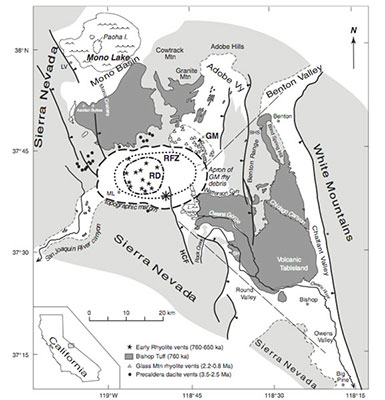
Fig. 2 Outline map of Long Valley caldera and the Bishop Tuff (Hildreth, 2007)
Strata of the Bishop Tuff
The Bishop Tuff was first mapped, described and named by Gilbert in 1938 (Bailey, 1976). The eruptive sequence of the Bishop tuff includes a fall deposit (F) that has been divided into nine units (F1–F9) (Hildreth, 2007). It has also been divided into about 13 packages of ignimbrite (Ig) (Fig. 3) (Hildreth, 2007). Ignimbrites consist of a poorly sorted mixture of ash and pumice lapilli.
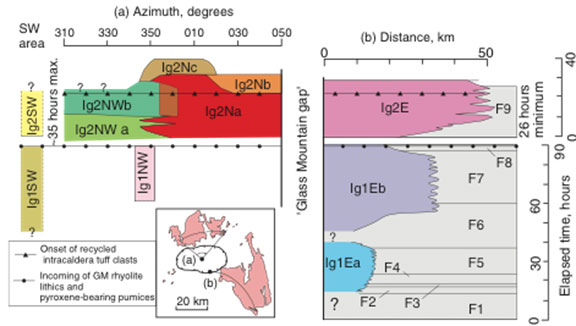
Fig. 3 Summary of stratigraphic relationships and estimate emplacement durations of the Bishop fall units and ignimbrite packages (Hildreth, 2007)
In this fall sequence there is no sign of a time break except for a possible short break between F8 and F9 (Hildreth, 2007). Between these two units, there seems to be a few centimeters of ash that did not have time to settle (Fig. 4). The eruption that created the Bishop tuff began in the caldera, creating a large plume that was blown eastward. East, and SE, of the vent, ignimbrite packages off lapped, each one depositing further away from the vent (Hildreth, 2007). The accumulation time for units F1–F8 is 90 h. Originally, it was thought that the accumulation time for the unit F9 was at least 8 h; but since the F9 unit is at least 207 centimeters thick on the west side of the White Mountains, the accumulation time is estimated at about 26 h (Hildreth, 2007).
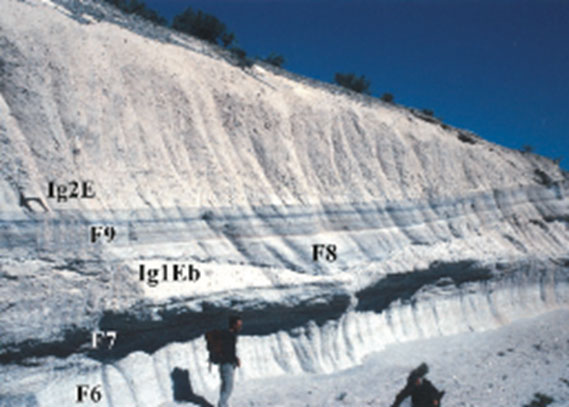
Fig. 4 – Chalfant Valley Pumice Quarry 42 km ESE of vent (Hildreth, 2007)
Cooling of the Bishop Tuff
Cooling and welding of an ash–flow tuff occurs after an eruption and the creation of gravity driven density currents of hot ash and gas (Sheridan, 2005). As soon as hot ash comes to rest, compaction of a tuff starts. The process of welding the tuff is dependent on the temperature and pressure distribution within the sheet of volcanic material. As the tuff cools, the rate of welding deformation slows (Sheridan, 2005). The lower, central part of the tuff has the maximum density for it is where heat is retained the longest. The top and bottom of the tuff cool rather quickly, which permits minimum compaction (Sheridan, 2005).
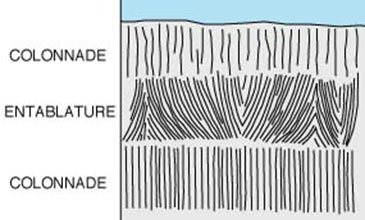
Fig. 5 Visual description of colonnade vs. entablature columnar jointing ("Columnar Jointing," 2012).
Columnar jointing occurs in lava flows, as well as ash flow tuffs. Columns form when volcanic material contracts as it cools. Cracks are formed from this cooling, and once a crack develops, it continues to grow ("Columnar Jointing," 2012). The cracks in this jointing are perpendicular to the surface. These cracks then form columns; many columns have 5 or 6 sides. Straight, regular columns are called colonnade. Irregular fracture columns are called entablature (Fig. 5) ("Columnar Jointing," 2012). This jointing is visible in the Bishop tuff; one example of it is within the Owens River Gorge, which was formed when the Owens River cut through part of the Bishop tuff. Both entablature and colonnade columns are visible (Fig. 6). The tuff exposed in the Owens River Gorge is a double cooling unit, which suggests that it was deposited during two eruptives.
The Bishop Tuff Eruption
The Bishop Tuff is the product of one of the greatest volcanic eruptions to occur on Earth, which happened about 760,000 years ago (Hill, 2006). The Long Valley caldera collapsed after this eruption, creating the 12 km by 22 km caldera. In the past 4 to 5 million years, there have been over 200 volcanic eruptions in the Long Valley region. The Bishop tuff eruption is by far the largest (Hildreth, 2007). There is evidence to show that the magma that is represented by the Bishop Tuff had been stored in a single magma chamber. The chamber would have been differentiated, low in temperature, rich in gas and was poor in phenocrysts at the roof, which is where withdrawal began (Hildreth, 2007). If there had been two or more magma bodies, each one would have to have its own fall deposit. The ash falls of the Bishop Tuff erupted at temperatures of 745 degrees Celsius under a pressure of less than 2kbar (Bailey, 1976), The ash flows erupted at 800 degrees Celsius under pressures of greater than 3kbar (Bailey, 1976), The roof of the chamber suggested to be at a depth around 6 km, while the ash flows came from a depth of about 10 km (Bailey, 1976).
The volume of this eruption is not certain due to erosion, filling in of the caldera, and irregular faulting of the caldera (Hildreth, 2007). It is difficult to estimate the volume of Bishop ash that was carried away by winds and dispersed over the western United States. Using the distribution of Bishop ash, one half the maximum thickness of Bishop pumice fall in the caldera vicinity and using logarithmic thinning of the ash downwind, the volume is calculated to be 600 km3 (Bailey, 1976).
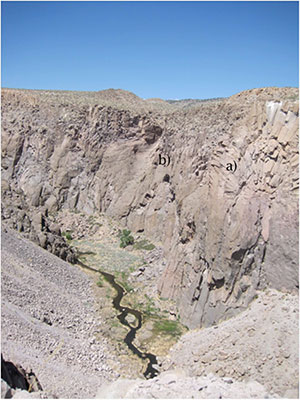
Fig. 6 The Owens River Gorge columnar jointing of the Bishop Tuff. a) Entablature columnar jointing resembling a rosette pattern b) colonnade columnar jointing.
Conclusion
The Bishop tuff is a welded tuff that was created 760,000 years ago during one of the largest volcanic eruptions on Earth. The same eruption formed the Long Valley Caldera in eastern California. Within the Long Valley Caldera, the Bishop Tuff has a volume of 345 km3 and a volume of 200 km3 outside of the caldera. At its thickest, within the caldera, the tuff is suggested to be 1000–1500 m thick. Fallout from the Bishop eruption is 2,5 x 10 km2 in area, stretching from the Pacific ocean to Nebraska. Consisting of Volcanic ash and pumice lapilli, the Bishop tuff accumulated its material during a 6 day volcanic eruption. Columnar jointing of the tuff is visible within the Owens River Gorge, as well as a possible double cooling unit. The eruption of a single magma chamber formed the tuff. The magma chamber would have been differentiated, with a low temperature, high gas content and was poor in phenocrysts at the roof where the evacuation began.
Acknowledgments
Roy Bailey for his work with the Long Valley and Mono Basin area. Katie Nold and her ability to explain things clearly while still driving safely. Michael Hamburger and John Rupp for their enthusiasm towards geology and other sciences, and the creation of this fantastic course that has brought about this paper.
Works Cited
Bailey, Roy A., G. Brent Dalrymple, and Marvin A. Lanphere. Volcanism, Structure, and Geochronology of Long Valley Caldera, Mono County, California. Journal of Geophysical Research 81.5 (1976): 725–44. Print.
Columnar Jointing. Columnar Jointing. Oregon State, n.d. Web. 10 June 2012. website.
Hildreth, W., and C. J. N. Wilson. Compositional Zoning of the Bishop Tuff. Journal of Petrology 48.5 (2007): 951–99. Print.
Hill, Mary. Geology of the Sierra Nevada. Berkeley: University of California, 2006. Print.
Sheridan, M., and Y. Wang. Cooling and Welding History of the Bishop Tuff in Adobe Valley and Chidago Canyon, California. Journal of Volcanology and Geothermal Research 142.1–2 (2005): 119–44. Print.